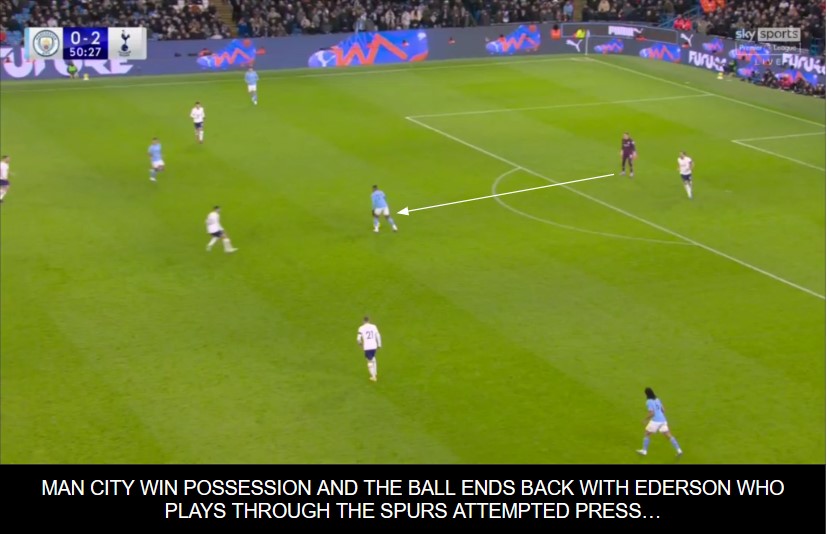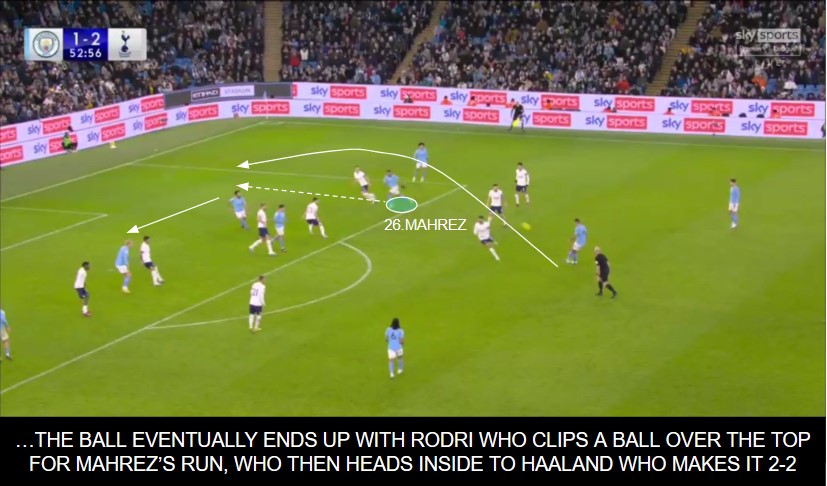Manchester City vs Tottenham Hotspur - Premier League 22/23 (19.01.23)
- Tactical Observer
- Jan 20, 2023
- 10 min read
Former Manchester City assistant manager, and current Qatari club Al-Sadd manager, Juanma Lillo stated, in a translated interview recently shared across social media, that; “In football, you can be ‘defending’ with the ball, and I can also be ‘attacking’ without the ball.”
And in last night’s (19.01.23) Premier League clash at the Etihad Stadium, between Manchester City and Tottenham Hotspur, the second half of that statement was in clear evidence.
This fixture was a coming together of this season’s current; first (Man City 46) and third (Spurs 37) highest goal scoring teams, and also the first (Haaland 21) and second (Kane 15) highest goal scoring players (all figures stated were correct before kick-off).
And even ignoring the statistics, for the footballing purists, it was a game that featured the attacking talents, such as Mahrez, Son, Grealish, Kulusevski and Álvarez, to name but a few.
But in a goal-packed, 4-2 comeback win for the home side, it was not necessarily either team’s attacking talent which had the biggest impact upon the game nor score line. In fact, the bigger influence on both the result, and the general story of the game, was each team’s approach out of possession.
In the (translated) words of Juanma Lillo, both teams were very much ‘attacking’ without the ball.
Lineups
The below animation shows the lineups of both teams and how they were typically positioned in and out of possession, and in different phases of the pitch.
The focus of this piece is how both team's out of possession approach was the key tactic to help them attack - and ultimately, how these approaches had the biggest influence on the final result.
OUT OF POSSESSION APPROACHES
Within the opening two minutes of the game, both team's intentions out of possession were clear.
Below you can see how after 24 seconds Man City were pressing the Spurs back three, with Alvarez and Gundogan also pushed up tight to their double pivot, to force Spurs going more direct and bypassing their midfield. In this example, the fact that Mahrez has angled his press out towards the left-footed Davies means there is no passing lane inside to Son, in the left half-space. But even if there was, Man City had both Rodri and Lewis (now spinning back to cover the Perisic at left wingback anticipating Davies' pass) in good proximity to close him down.

Just after a minute of play, it was Spurs' turn to show their intention without the ball. Here a backwards pass to Ederson has sprung the Spurs high press with Kane angling his run towards the goalkeeper to force him into playing out via the City left-hand side. This 'cue' from Kane is the signal to both Kulusevski and Emerson (not yet in shot) to be ready to fulfil their roles.

And below in the follow up image, you can now see Emerson pushed high up the pitch ready to engage Ake who has just received the ball.

Now these examples weren't just the frantic openings of a game, where both teams were trying to seize the ascendancy. No, there were just a prelude to the tactical story of the game.
Before showing some more examples from both sides, here's a brief overview of each team's intentions and roles out of possession. Plus, my rationale as to why each team decided to approach the game without the ball in this way.
From a Manchester City perspective, their high press resembled a 433 shape which collapsed into a 541 low-block with Rodri dropping between the two central defenders when defending their own box. But our focus is on the City high press, so here's an overview of each defensive line, and individual players, roles and responsibilities.
Front Three: the three forward players; Mahrez (right side), Haaland (central) and Grealish (left side), main priorities were the Spurs back three (and goalkeeper). Each player pressed the direct opponent (Mahrez → Davies, Haaland → Dier + Lloris, Grealish → Romero), often trying to force Spurs towards the touchline which they could then use as an additional defender + it allowed the rest of the Man City team behind to focus their pressing target, as it cut off the opposite side of the pitch.
A final observation on the front three was that the ball-far winger (winger on the opposite side to where the ball currently was) would ensure he tucked inside and dropped slightly, so that if Spurs broke the press, they were in closer proximity to get back and help the team defend their own half.
Midfield Three: the three midfield players; Alvarez (right side), Rodri (central) and Gundogan (left side), tended to play on different horizontal lines and had different defensive responsibilities. Alvarez and Gundogan were tasked with pushing up and getting tight to the Spurs double pivot to 1) limit Spurs' use of their double pivot (a key component of their build up play) and 2) if they did receive the ball, be immediately positioned to engage them and try to win the ball back in high and central areas.
At times, Alvarez, in the opening stages of the game, appeared to be near man-marking Bentancur (arguably the more press resistant of the Spurs double pivot). It was clear, City did not want Bentancur to be a frequent feasible passing option in their build up due to how tightly Alvarez was tracking him. Gundogan, on the other hand, whilst still getting tight to Hojberg at times, seemed to allow a bit more space initially, perhaps to encourage Spurs to make the pass into him and then press from there. In my opinion, whilst Hojberg is a good all-round central midfield player, between him and Bentancur, he is the one less likely to try (and therefore beat) a tight press and then find a forward pass, instead choosing more often to play safe and pass backwards or out wide when pressed - exactly what Man City would have wanted. So you could say, from the opposition's point of view, Hojberg is more 'press submissive' as opposed to 'press resistant'.
In behind Alvarez and Gundogan was Rodri; and the Spanish player's role was multifaceted. In recent games (and prior to that) Man City have tended to form a 442 shape out of possession and therefore, with Alvarez's inclusion, this seemed like it would be the likely choice for this match too. But I suspect, in addition to the benefits mentioned above of playing Alvarez - in essence as a right-sided central midfielder, another reasoning may also have been that in a 442, it would require Rodri to often jump up to engage the Spurs double pivot and therefore vacating central areas. And worse than that - thinking back to City's previous losses to Spurs in the recent seasons - it would have also opened up more passing options into Kane's feet after dropping short, where he could then turn and play those passes in behind for the usual runners. Something perhaps Man City intentionally decided to try and restrict today with their tactics.
In addition to helping occupy central areas without the ball, Rodri was also tasked with covering, and supporting, his teammates in the high press. This could involve pushing out to the half-spaces to help cover Son or Kulusevski (if neither the fullback nor central defender were able to), jumping up to cover the spaces in behind the more advanced central midfielders or dropping into the backline as additional cover.
Back Four: the four players in the City backline; Lewis (right fullback), Stones (right-sided central defender), Akanji (left-sided central defender) and Ake (left fullback), pushed up high to support the high press and were all very active, with multiple responsibilities.
The two fullbacks were tasked with being ready to push in with the two Spurs inside forwards (Son and Kulusevski) when they dropped deeper into the half spaces, and also, be in a position to get out to the Spurs wingbacks, if play looked like it was developing that way. On the occasions when Lewis would have to pass on Son to get out to Perisic, Stones would push up to pick up the South Korean. The same would happen on the opposite side with Ake and Akanji. When this situations did occur, the remaining two ball-far defenders, and Rodri, would both drop and tuck inside to help cover Kane.
Now following the written detail above, here's some examples of this Man City high press in reality. Click the image to expand.
Man City's out of possession approach intended to; disrupt Spurs build up play by pressuring the back three when in possession to force mistakes and rush passes, cut off or at least limit the use, and effectiveness, of their double pivot and therefore prevent the supply, and probably more importantly - the quality, in to the front three.
All of this helped City force turnovers and win back possession from Spurs which not only allowed them more opportunities to 'control' the game, but it also allowed them to regain the ball against an often stretched and disjointed Spurs, where they could then try to exploit these spaces.
In my view, the secondary benefit of this out of possession approach, was the main rationale as to why City set-up in this way. As Spurs get into 541 low block, spaces to exploit in between and in behind are at a premium. So therefore, City needed to try and manufacture space against a team that, ordinarily when defending deep, doesn't give up much - apart from in front of them.
City therefore decided that a key attacking tactic in this game would be their approach without the ball.
And whilst in the 1st half, City's approach was effective without any end-product, the 2nd half - as we'll come onto shortly - was a different story.
From a Tottenham Hotspur perspective, their high press seemed exclusively reserved for when Ederson had, or was about to have, possession of the ball. In these situations, their forward line, double pivot and ball-side wingback would all push up high into the City half to engage. Even the Spurs backline would be positioned near the halfway line so able to follow in their City opponent, if they dropped deep to try and help their teammates play out.
But whilst this high press from Spurs was clearly impactful and contributed to their two goals at the end of the 1st half, what was more impressive at times was their mid-block and mid-press. As it was often from this mid-block to mid-press that Spurs forced City back towards Ederson where they then triggered their high press.
Here's a brief overview of Spurs' mid-block and mid-press, including general team aims and individual player roles and responsibilities.
From a team point of view, the aim appeared quite simple - block the centre of the pitch and avoiding Man City's 3-2 base have controlled and unopposed spells of possession (also blocking passing lanes into the half-spaces) and force their play into wider areas where Spurs would engage, ideally to force turnovers and then attack themselves, or failing that, delay City's progression up the pitch so the team had time to drop back into their low block shape.
The top half of Spurs' mid-block mirrored City's 3-2 base, so in essence it was 5v5 in the middle of the pitch and then 5v5 in behind (five City forwards versus Spurs backline of five).
In Spurs' mid-block;
Kane would be positioned in front of Akanji but also he would use his cover shadow to try and block passes into Rodri
Kulusevski (right side) and Son (left side) would be positioned narrow in order to help block passing lanes in behind to the half-spaces and also in close proximity so able to help press inside too. But importantly, they would also be positioned, and primed, to be able to get out to the wide central defenders on their side (Son → Stones & Kulusevski → Ake)
Behind the forward line was the Spurs double pivot of Bentancur and Hojberg, who returned the favour and pushed up tight to City's double pivot. Hojberg (when playing as the left-sided central midfield) was very tight to Lewis, whereas due to Kane's cover shadow on Rodri, Bentancur could, at times, have a slightly deeper starting position before jumping to press - this looked to be so he could also help cover Gundogan's movement in the left half-space
Then the Spurs backline, in essence all had man-orientated responsibilities, with the wingbacks covering the City wingers, the wide central defenders (Romero and Davies) jumping up to the half-spaces to engage the City players occupying these zones and Dier with Haaland.
Spurs would primarily sit in their mid-block when Akanki had possession, with Kane creeping towards him to force him into action, or if they were not all in good positions to initiate the press. But the main triggers of the Spurs mid-press appeared to be when the ball when out to one of the wide central defenders or inside to one of the double pivot and therefore Spurs players were in close proximity to engage as a unit.
Here are some examples of Spurs' high press, mid-block and mid-press in reality from the 1st half.
These out of possession tactics are not anything relatively new from Spurs. But against City, due to their style of play, and City's in possession structure mirroring their out of possession block, and as City will give you (or at least give you hope) that there will be opportunities to win possession high and then attack the space, Spurs' attacking tactics very much centered around not having the ball.
INFLUENCE ON THE RESULT
As alluded to already, both team's out of possession approaches, in my view, had the biggest influence on the final result.
Spurs' opening goal came from their mid-press forcing City back towards Ederson and then their high press forcing Ederson into a mistake by trying to play into, and on the wrong side, of Rodri. Following this attempted pass, Rodri could only divert the ball into the path of Kulusevski who fired the ball into the net to put Spurs into a 1-0 lead.

At half-time, City were trailing 2-0. The Sky Sports pundits and commentary team were therefore assuming multiple changes in personnel, and perhaps approach, in the 2nd half.
But City did neither. Instead they stuck to their tactics - as mentioned, in the 1st half it was proving to be effective without the final outcome - and within 8 minutes of play resuming they were level. With their out of possession approach having a key influence in both of their goals.
Below are some of the key moments from the sequence which led to City's first goal. To summarise, Man City's high press forced Spurs into playing back to Lloris, and in an attempt to help his team and relieve some of the pressure (plus, there being limited passing options available), the Spurs goalkeeper opts to loft a pass out to the flank but City are able to regain the ball and then initiate an attack from deep.
The second City goal, again, comes from City pressure high up the pitch. In this sequence, City have forced Spurs over to the left-hand side touchline - and perhaps, wary of going long and losing possession anyway - Davies attempts a pass up the line to Perisic but due to City's press having swarmed that side of the pitch, City win the turnover, and then following some passing combinations, they work the ball inside to Rodri who then clips a pass over the top of the Spurs backline for Mahrez making a depth run who then heads into the 6-yard box, where Haaland nods home to level the game.
Man City's relentless pressure, and the swing of momentum - not withstanding a slice of luck with a Perisic missing a clear goal scoring opportunity due a trailing leg from Lewis at 2-2 - eventually resulted in them taking a 3-2 lead on 63 minutes, before putting the game to bed on 90 minutes to finish as 4-2 winners.
CLOSING THOUGHTS
The post-match headlines from the game will be about City's thrilling comeback and Guardiola's call for more "passion" and "fire" from both his team and the home crowd, but the real story of the game was about how both team's planned to 'attack' without the ball.
Thank you for reading this tactical story.
All game screengrabs were captured from Sky Sports.


















































Comments